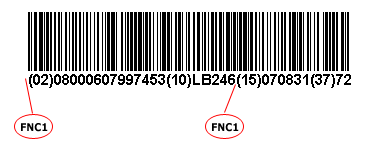Linear Barcodes FAQ |
|||||||||||||||||||||||||||||||||
|
|
|||||||||||||||||||||||||||||||||
What is a barcode X-dimension |
|||||||||||||||||||||||||||||||||
The X-dimension is the width of the smallest element in a bar code.
The minimum X-dimension for an "open system" (a bar code label that will be read by scanners
from outside your company) is 7.5 mils (a mil is 1/1000 inch) or 0.19 mm.
The X dimension is measured in Mils, 1 Mil = 1/1000 Inch.
Very often barcode parameters are specified in Mils in various standards. But they can be
also specified in inches and in millimeters. To switch from one unit to another, the
following ratios can be used:
1 Mils = 0.001 InchBelow is a chart that contains many common dimensions.
|
|||||||||||||||||||||||||||||||||
Is it possible to encode binary data with linear barcodes? |
|||||||||||||||||||||||||||||||||
|
Yes, it is, but not the entire range of binary data. For example, Code 39 Extended and Code 93 Extended allow
you to encode data within the range 0..127 (00..7F hex).
Since data for encoding must be presented as a string, you have to convert binary data to a string to be able to encode it. Suppose you need to encode the following byte array: 00 01 02 03 (it is binary data)To do it, you should set the following properties: BarType - Code 39 Extended (or Code 93 Extended) |
|||||||||||||||||||||||||||||||||
How can I insert FNC1 into barcodes of the UCC/EAN128 type? |
|||||||||||||||||||||||||||||||||
Actually, you do not have to do it yourself because our barcodes controls can place FNC1 where it
needs to be. Suppose you need to encode the following UCC/EAN128 barcode:
(02)08000607997453(10)LB246(15)070831(37)72To do it, just attribute the following string to the BarText property: <AI02>08000607997453<AI10>LB246<AI15>070831<AI37>72You will get the following barcode as a result: 
The FNC1 character is an invisible character, but it is really encoded in the barcode (unlike parentheses, which are displayed but not encoded in the barcode). As you can see from the image above, the FNC1 character is inserted not after each AI (Application Identifier), but only after those AI that have a variable length. In this barcode only two AI have variable length: 10 and 37. FNC1 is not inserted after AI-37 only because 37 is the last AI and there is no need to encode FNC1 at the end of a barcode. FNC1 are also encoded at the beginning of any UCC/EAN128 barcode (it is a feature of a UCC/EAN128 bar code). That is, our barcode control places FNC1 where it is needed, but if you want to insert FNC1 somewhere else, you can use the string "<FCN1>". For instance: <AI02>08000607997453<AI10>LB246<AI15>070831<AI37>72<FNC1>This will result in additional FNC1 inserted at the end of the barcode. See also:
|
|||||||||||||||||||||||||||||||||
What should I so if an AI has a variable length (UCC/EAN128)? |
|||||||||||||||||||||||||||||||||
| As it is explained here, our barcode controls can detect variable-length AI, so you do not have to add any special characters. | |||||||||||||||||||||||||||||||||
I use BarCode ActiveX and try to print a Code128C barcode, but for some reason I have a leading zero that should not be there inserted into the barcode. Is it possible to get rid of this digit? |
|||||||||||||||||||||||||||||||||
| The thing is that a Code128C barcode can encode only an even number of numerals. You must have specified an odd number of them so our barcode control added this leading zero. So, use only even numbers of numerals or use another type of Code128, e.g. Auto or Code128B. |
